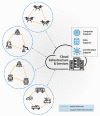Emerging MIMO Technologies for 6G Networks
- PMID: 36850518
- PMCID: PMC9961246
- DOI: 10.3390/s23041921
Emerging MIMO Technologies for 6G Networks
Abstract
The demand for wireless connectivity has grown exponentially over the last years. By 2030 there should be around 17 billion of mobile-connected devices, with monthly data traffic in the order of thousands of exabytes. Although the Fifth Generation (5G) communications systems present far more features than Fourth Generation (4G) systems, they will not be able to serve this growing demand and the requirements of innovative use cases. Therefore, Sixth Generation (6G) Networks are expected to support such massive connectivity and guarantee an increase in performance and quality of service for all users. To deal with such requirements, several technical issues need to be addressed, including novel multiple-antenna technologies. Then, this survey gives a concise review of the main emerging Multiple-Input Multiple-Output (MIMO) technologies for 6G Networks such as massive MIMO (mMIMO), extremely large MIMO (XL-MIMO), Intelligent Reflecting Surfaces (IRS), and Cell-Free mMIMO (CF-mMIMO). Moreover, we present a discussion on how some of the expected key performance indicators (KPIs) of some novel 6G Network use cases can be met with the development of each MIMO technology.
Keywords: 6G networks; IRS; XL-MIMO; cell-free mMIMO; massive MIMO.
Conflict of interest statement
The authors declare no conflict of interest.
Figures








References
-
- Goyal J., Singla K., Akashdeep, Singh S. Second International Conference on Computer Networks and Communication Technologies (ICCNT 2019) Springer International Publishing; Berlin/Heidelberg, Germany: 2020. A Survey of Wireless Communication Technologies from 1G to 5G; pp. 613–624. - DOI
-
- Navarro-Ortiz J., Romero-Diaz P., Sendra S., Ameigeiras P., Ramos-Munoz J.J., Lopez-Soler J.M. A survey on 5G usage scenarios and traffic models. IEEE Commun. Surv. Tutor. 2020;22:905–929. doi: 10.1109/COMST.2020.2971781. - DOI
-
- Björnson E., Sanguinetti L., Hoydis J., Debbah M. Optimal Design of Energy-Efficient Multi-User MIMO Systems: Is Massive MIMO the Answer? IEEE Trans. Wirel. Commun. 2015;14:3059–3075. doi: 10.1109/TWC.2015.2400437. - DOI
-
- Wang Z., Zhang J., Du H., Sha W.E., Ai B., Niyato D., Debbah M. Extremely Large-Scale MIMO: Fundamentals, Challenges, Solutions, and Future Directions. arXiv. 2022 doi: 10.48550/ARXIV.2209.12131. - DOI
-
- Ding Z., Vincent Poor H. A Simple Design of IRS-NOMA Transmission. IEEE Commun. Lett. 2020;24:1119–1123. doi: 10.1109/LCOMM.2020.2974196. - DOI
Publication types
Grants and funding
- 01 245.010 604/2 020-14,/National Education and Research Network
- 2070.01.0004709/2021-28/Fundação de Amparo à Pesquisa do Estado de Minas Gerais
- Project UIDB/EEA/50008/2020/FCT/MCTES
- 305021/2021-4, 311470/2021-1, 402378/2021-0, 600 403827/2021-3, 313213/2021-6;/National Council for Scientific and Technological Development
- 2018/23097-3 (SFI2), 2022/03457-0 (SAMURAI), 2020/05152-7 (PROFISSA)/São Paulo Research Foundation
LinkOut - more resources
Full Text Sources
Miscellaneous

